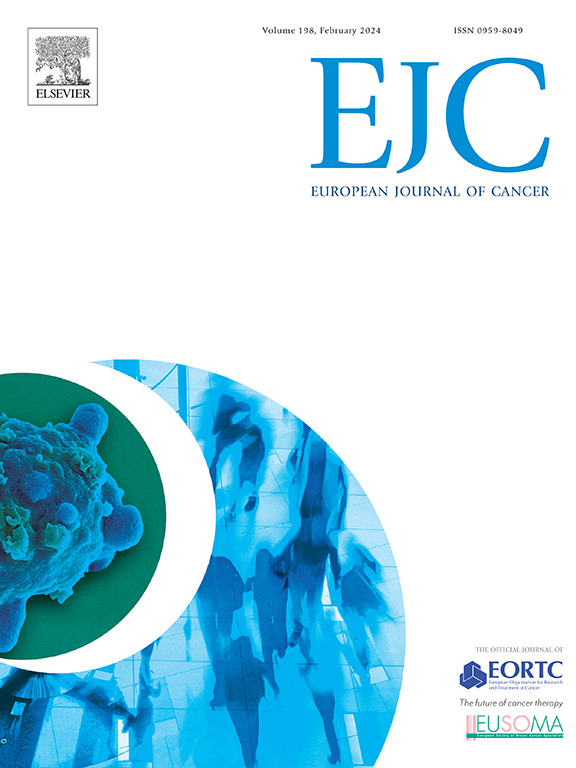Inavolisib plus letrozole or fulvestrant in PIK3CA-mutated, hormone receptor-positive, HER2-negative advanced or metastatic breast cancer (GO39374): An open-label, multicentre, dose-escalation and dose-expansion phase 1/1b study
IF 7.6
1区 医学
Q1 ONCOLOGY
引用次数: 0
Abstract
Background
A variety of treatment options continue to be explored in the post–cyclin-dependent kinase 4/6 inhibitor (CDK4/6i) setting for hormone receptor (HR)-positive, HER2-negative locally advanced/metastatic breast cancer (LA/mBC), and optimal sequencing of therapies remains to be determined. This phase 1/1b study examined inavolisib, a potent and selective PI3Kα inhibitor that promotes mutated p110α degradation, alone and in combination with endocrine therapy (ET) ± palbociclib, in PIK3CA-mutated, HR-positive, HER2-negative LA/mBC. We report data on inavolisib plus ET, including in patients who had previously received a CDK4/6i.
Methods
Women age ≥ 18 years received inavolisib (6 mg/9 mg orally once daily [PO QD]) plus letrozole (2·5 mg PO QD), or inavolisib (9 mg PO QD) plus fulvestrant (500 mg intramuscularly on Days 1 and 15 of Cycle 1 then every 4 weeks), until unacceptable toxicity/disease progression. Primary endpoint: safety and tolerability.
Findings
Thirty-seven and 60 patients were enrolled in the inavolisib plus letrozole and inavolisib plus fulvestrant arms, respectively. Overall, treatment-related adverse events (mostly low grade) occurred in 94·6 % and 93·3 % of patients, respectively; the most frequent (≥10 % of patients in either arm) were hyperglycaemia, stomatitis, nausea, and diarrhoea. Confirmed objective response rates in patients with measurable disease were 9·7 % and 25·9 %, respectively; median progression-free survival was 3·7 and 7·3 months. Among patients with previous CDK4/6i therapy (29/37 and 58/60 patients, respectively), confirmed objective response rates were 13·0 % and 25·0 %; median progression-free survival was 3·7 and 7·1 months. No drug–drug interactions were observed for any study treatment. Paired baseline and Cycle 1 Day 15 tumour biopsies and circulating tumour DNA analyses demonstrated the impact of study treatment on pharmacodynamic/pathophysiologic biomarkers of response.
Interpretation
Inavolisib plus ET demonstrated a manageable safety profile and encouraging preliminary anti-tumour activity in patients with PIK3CA-mutated, HR-positive, HER2-negative LA/mBC, including those in the post-CDK4/6i setting.
Inavolisib联合来曲唑或氟维司汀治疗pik3ca突变、激素受体阳性、her2阴性的晚期或转移性乳腺癌(GO39374):一项开放标签、多中心、剂量递增和剂量扩大的1/1b期研究
在细胞周期蛋白依赖性激酶4/6抑制剂(CDK4/6i)治疗激素受体(HR)阳性、her2阴性的局部晚期/转移性乳腺癌(LA/mBC)的过程中,各种治疗方案仍在继续探索,最佳治疗方案仍有待确定。这项1/1b期研究检测了inavolisib,一种有效的选择性pi3ka α抑制剂,可促进突变的p110α降解,单独或联合内分泌治疗(ET) ± palbociclib,用于pik3ca突变,hr阳性,her2阴性的LA/mBC。我们报告了inavolisib + ET的数据,包括先前接受过CDK4/6i的患者。方法年龄≥ 18岁的女性接受inavolisib (6 mg/9 mg口服,每日1次[PO QD])加来曲唑(2.5 mg PO QD),或inavolisib(9 mg PO QD)加氟维司汀(500 mg肌肉注射,第1周期第1天和第15天,然后每4周),直到不可接受的毒性/疾病进展。主要终点:安全性和耐受性。研究结果:分别有37例和60例患者被纳入了依那维西加来曲唑组和依那维西加氟维西组。总体而言,与治疗相关的不良事件(主要是低级别)分别发生在94.6% %和93.3% %的患者中;最常见的(≥10 %)是高血糖、口炎、恶心和腹泻。在可测量疾病的患者中,确认的客观缓解率分别为9.7% %和25.9% %;中位无进展生存期分别为3.7个月和7.3个月。在既往接受过CDK4/6i治疗的患者中(分别为29/37和58/60),确认的客观缓解率分别为13.0 %和25.0 %;中位无进展生存期分别为3.7和7.1个月。在任何研究治疗中均未观察到药物-药物相互作用。配对基线和第1周期第15天肿瘤活检和循环肿瘤DNA分析证明了研究治疗对药效学/病理生理生物标志物反应的影响。inavolisib + ET在pik3ca突变、hr阳性、her2阴性的LA/mBC患者(包括cdk4 /6i后患者)中显示出可控的安全性和令人鼓舞的初步抗肿瘤活性。
本文章由计算机程序翻译,如有差异,请以英文原文为准。
求助全文
约1分钟内获得全文
求助全文
来源期刊

European Journal of Cancer
医学-肿瘤学
CiteScore
11.50
自引率
4.80%
发文量
953
审稿时长
23 days
期刊介绍:
The European Journal of Cancer (EJC) serves as a comprehensive platform integrating preclinical, digital, translational, and clinical research across the spectrum of cancer. From epidemiology, carcinogenesis, and biology to groundbreaking innovations in cancer treatment and patient care, the journal covers a wide array of topics. We publish original research, reviews, previews, editorial comments, and correspondence, fostering dialogue and advancement in the fight against cancer. Join us in our mission to drive progress and improve outcomes in cancer research and patient care.
 求助内容:
求助内容: 应助结果提醒方式:
应助结果提醒方式:


